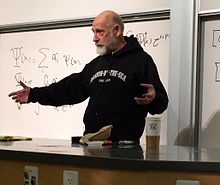Leonard Susskind | |
|---|---|
 Susskind in 2013 | |
| Born | June 16, 1940[2] New York City, U.S. |
| Alma mater | City College of New York (BS) Cornell University (PhD) |
| Known for | Black hole complementarity Causal patch Color confinement ER=EPR Hamiltonian lattice gauge theory Holographic principle Matrix theory (physics) String theory String theory landscape Worldsheet RST model Susskind–Glogower operator Kogut–Susskind fermions Fischler–Susskind mechanism |
| Awards | Dirac Medal (2023) Oskar Klein medal (2018) Pomeranchuk Prize (2008) Science Writing Award (1998) Sakurai Prize (1998) Boris Pregel Award (1975)[1] |
| Scientific career | |
| Fields | Physics, mathematics |
| Institutions | Yeshiva University Tel Aviv University Stanford University Stanford Institute for Theoretical Physics Korea Institute for Advanced Study Perimeter Institute for Theoretical Physics |
| Thesis | Quantum mechanical approach to strong interactions (1965) |
| Doctoral advisor | Peter A. Carruthers |
| Doctoral students | Eduardo Fradkin Barak Kol Douglas Stanford |
Leonard Susskind (/ˈsʌskɪnd/; born June 16, 1940)[2][3] is an American theoretical physicist, Professor of theoretical physics at Stanford University and founding director of the Stanford Institute for Theoretical Physics. His research interests are string theory, quantum field theory, quantum statistical mechanics and quantum cosmology.[1] He is a member of the US National Academy of Sciences,[4] and the American Academy of Arts and Sciences,[5] an associate member of the faculty of Canada's Perimeter Institute for Theoretical Physics,[6] and a distinguished professor of the Korea Institute for Advanced Study.[7]
Susskind is widely regarded as one of the fathers of string theory.[8] He was the first to give a precise string-theoretic interpretation of the holographic principle in 1995[9] and the first to introduce the idea of the string theory landscape in 2003.[10][11]
Susskind was awarded the 1998 J. J. Sakurai Prize,[12] and the 2018 Oskar Klein Medal.[13]
- ^ a b "Faculty information sheet". Stanford University. Archived from the original on March 9, 2013. Retrieved September 1, 2009.
{{cite journal}}: Cite journal requires|journal=(help) - ^ a b "Lennyfest". May 20–21, 2000. Archived from the original on October 17, 2013. Retrieved July 1, 2007:his 60th birth anniversary was celebrated with a special symposium at Stanford University.
- ^ "Why is Time a One-Way Street?". June 26, 2013:in Geoffrey West's introduction, he gives Suskind's current age as 74 and says his birthday was recent.
- ^ "60 New Members Chosen by Academy". National Academy of Sciences (press release). May 2, 2000. Retrieved September 1, 2009.
{{cite journal}}: Cite journal requires|journal=(help) - ^ Cite error: The named reference
bioAtEdgewas invoked but never defined (see the help page). - ^ "Leonard Susskind Joins PI". October 15, 2007. Archived from the original on September 24, 2015. Retrieved December 6, 2012.
- ^ "Susskind, Leonard: Distinguished Professor / School of Physics: Theoretical Particle Physics". Korea Institute for Advanced Study. Archived from the original on April 20, 2014. Retrieved December 6, 2012.
- ^ "Father of String Theory Muses on the Megaverse". NYAS Publications.
- ^ Susskind, Leonard (1995). "The World as a Hologram". Journal of Mathematical Physics. 36 (11): 6377–6396. arXiv:hep-th/9409089. Bibcode:1995JMP....36.6377S. doi:10.1063/1.531249. S2CID 17316840.
- ^ Leonard Susskind (2003). "The Anthropic Landscape of String Theory". The Davis Meeting on Cosmic Inflation: 26. arXiv:hep-th/0302219. Bibcode:2003dmci.confE..26S.
- ^ Byrne, P. (2011). "Bad Boy of Physics". Scientific American. 305 (1): 80–83. Bibcode:2011SciAm.305f..80B. doi:10.1038/scientificamerican0711-80.
- ^ Cite error: The named reference
Sakuraiwas invoked but never defined (see the help page). - ^ "The Oskar Klein Memorial Lecture". Archived from the original on December 17, 2020. Retrieved February 4, 2019.